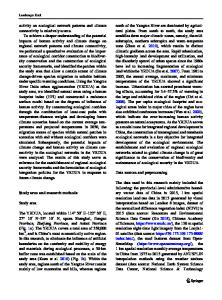Spatial Distribution Patterns and Influencing Factors of PM 2.5 Pollution in the Yangtze River Delta: Empirical Analysis
- PDF / 1,952,361 Bytes
- 13 Pages / 595.276 x 790.866 pts Page_size
- 82 Downloads / 294 Views
Online ISSN 1976-7951 Print ISSN 1976-7633
ORIGINAL ARTICLE
Spatial Distribution Patterns and Influencing Factors of PM2.5 Pollution in the Yangtze River Delta: Empirical Analysis Based on a GWR Model Meixia Wang 1
&
Huiping Wang 2
Received: 17 April 2019 / Revised: 19 September 2019 / Accepted: 15 October 2019 # Korean Meteorological Society and Springer Nature B.V. 2020
Abstract Based on the PM2.5 concentration and economic and social data in the Yangtze River Delta during 2006–2016, the spatial distribution characteristics of PM2.5 pollution and the spatial heterogeneity of its influencing factors are analyzed using exploratory spatial data analysis and a geographically weighted regression model. The results show the following . The PM2.5 pollution situation is serious and presents a remarkable feature of spatial agglomeration in the Yangtze River Delta. Highly polluted areas are mainly concentrated in the northern cities of the Yangtze River Delta, while the air quality of the southern cities of the Yangtze River Delta is better. There is a significant positive spatial spillover effect of PM2.5 pollution in the Yangtze River Delta, which is to say that the air quality will be worsened by the PM2.5 pollution of surrounding cities . The influence coefficients of the population density, industrial proportion, car ownership and FDI on PM2.5 have spatial heterogeneity; that is, there are significant differences in their degrees of influence between different periods and cities. Keywords Yangtze River Delta . PM2.5 . Spatial distribution characteristic . Geographically weighted regression model
1 Introduction Since the beginning of the twenty-first century, hazy weather has appeared frequently in China, spreading from North China to East, Central and Southwest China in turn. In December 2013, China suffered the most severe fog and haze in history, and 25 provinces were affected one after another, with the condition reaching an unprecedented extent and severity. In December 2016, severe pollution-related weather returned, sweeping over half of China again. The air quality in 71 cities was heavily polluted and above. Historically, the air quality in the Yangtze River Delta has been much better than that in Beijing, Tianjin and Hebei, where heavy industry is dominant. Responsible Editor: Yunsoo Choi. * Meixia Wang [email protected] 1
School of Economics and Management, Xi’an University of Technology, Xi’an 710054, China
2
School of Economics, Xi’an University of Finance and Economics, Xi’an 710100, China
However, during the two rounds of haze, it was also difficult for the pollution to escape the Yangtze River Delta. PM2.5 is an important source of haze pollution, that seriously interferes with people’s daily lives and health and has become a hot issue attracting worldwide attention. Therefore, it is imperative to control haze (Xie et al. 2014; Kioumourtzoglou et al. 2015; Loftus et al. 2015; Liu et al. 2017a; b; Zhao et al. 2019). The Chinese government has promulgated the 12th Five-Year Plan for the Preven
Data Loading...











